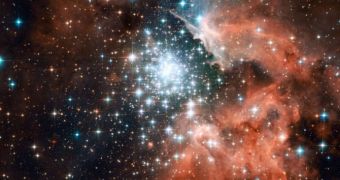Until now, astronomers thought they had a fairly clear comprehension of how stars moved across the sky. They believed that studies had evidenced most of the traits associated with this section of celestial mechanics, and this is precisely why the conclusions of a new study, only recently published, puzzled them considerably. Using data collected by the venerable NASA Hubble Space Telescope, researchers were able to peer at the motions of a group of stars in a particular star cluster. The data showed motions that the science team did not expect at all, and which surprised the researchers, Wired reports.
The observations were centered on a space structure known among astronomers as NGC 3603. This is a stellar nursery, a region of intense stellar formation where massive hydrogen clouds promote the formation of young, blue celestial fireballs. The Hubble was in 1997 pointed directly at the nebula's core cluster, on which it conducted a series of investigations. The same thing was performed again in 2007, when the not-yet-refurbished telescope repeated its exact actions.
Astronomers then looked at the two sets of photos and were able to infer the movement of hundreds of stars, most of which were new. There are really no very old stars in the structure, given that it was formed no more than 1.4 million years ago. This is the blink of an eye in geological and astronomical terms, and it implies that most of the stars within have not passed this age. The cluster itself, located no less than 20,000 light-years away from Earth, was thought to have settled down since the time of its formation, but this proved not to be the case. More than 800 stars were analyzed in both sets of Hubble images, and German researchers at the Max Planck Institute for Astronomy found peculiarities in their motions.
The team determined that most of the stars within were still moving at speeds and rates that were not in perfect tune with their own mass. According to investigators, this scenario is in tune to what astronomers would have expected to find in a cluster still in its earliest stages of formation. The new data could force the international scientific community to rethink the way it looks at cluster formation and development, the group believes. Additional details of the investigation appear in the June 2 issue of the highly-regarded astronomical publication Astrophysical Journal Letters.

 14 DAY TRIAL //
14 DAY TRIAL //